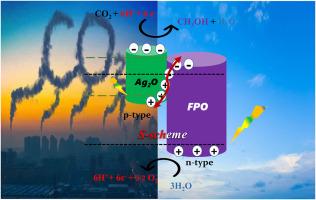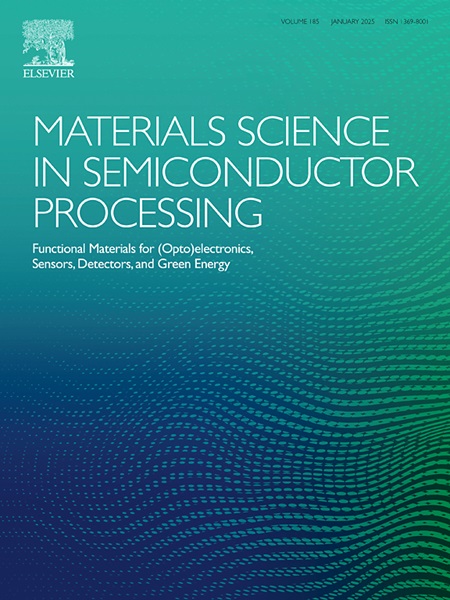Ag2O-supported FePO4 heterojunctions: Facile fabrication and fast visible-light carbon dioxide photoreduction into methanol with superb recyclability
IF 4.2
3区 工程技术
Q2 ENGINEERING, ELECTRICAL & ELECTRONIC
引用次数: 0
Abstract
The conversion of carbon dioxide (CO2) into clean fuels using semiconductor materials represents a sustainable and environmentally advantageous approach to energy generation. Extensive research is underway to develop robust and enduring photocatalysts for this purpose. This research focused on the synthesis of visible-light-responsive 1.0–4.0 wt% Ag2O-decorated FePO4 (FPO) nanocomposites using a surfactant-assisted sol-gel method and evaluated their ability to catalyze the photoconversion of CO2 into methanol. The addition of trace amounts of Ag2O expanded their visible-light absorption range, improved charge isolation, and enhanced mobility of photoexcited charges. This resulted in a bandgap reduction from 3.14 eV in pure FPO to 1.98 eV. Additionally, the surface structure examination revealed the production of mesoporous nanocomposites with a surface area ranging from 103 to 119 m2/g. Furthermore, a controlled dosage of 3 % Ag2O-FPO at 1.6 g/L produced CH3OH with a yield of 1612 μM g−1 after 9 h of illumination, approximately 2.2 times higher than the pure FPO. This stable and reusable heterojunction maintains 94 % of its initial performance after 5 cycles. This research highlights the potential of phosphates-based heterojunctions for producing sustainable fuels under visible illumination conditions.

Ag2O支撑的FePO4异质结:简易制备和在可见光下将二氧化碳快速光生成甲醇,并具有极佳的可回收性
利用半导体材料将二氧化碳(CO2)转化为清洁燃料是一种可持续的、对环境有利的能源生产方式。目前正在进行广泛的研究,以开发用于这一目的的坚固耐用的光催化剂。本研究采用表面活性剂辅助溶胶-凝胶法合成了可见光响应度为 1.0-4.0 wt% 的 Ag2O 装饰 FePO4(FPO)纳米复合材料,并评估了它们催化 CO2 光转化为甲醇的能力。痕量 Ag2O 的加入扩大了其可见光吸收范围,改善了电荷隔离,并增强了光激发电荷的流动性。这使得带隙从纯 FPO 的 3.14 eV 降至 1.98 eV。此外,表面结构检查显示,生成的介孔纳米复合材料的表面积在 103 至 119 m2/g 之间。此外,3 % Ag2O-FPO 的控制用量为 1.6 g/L,在光照 9 小时后产生的 CH3OH 产率为 1612 μM g-1,比纯 FPO 高出约 2.2 倍。这种稳定且可重复使用的异质结在循环 5 次后仍能保持 94% 的初始性能。这项研究凸显了基于磷酸盐的异质结在可见光照明条件下生产可持续燃料的潜力。
本文章由计算机程序翻译,如有差异,请以英文原文为准。
求助全文
约1分钟内获得全文
求助全文
来源期刊

Materials Science in Semiconductor Processing
工程技术-材料科学:综合
CiteScore
8.00
自引率
4.90%
发文量
780
审稿时长
42 days
期刊介绍:
Materials Science in Semiconductor Processing provides a unique forum for the discussion of novel processing, applications and theoretical studies of functional materials and devices for (opto)electronics, sensors, detectors, biotechnology and green energy.
Each issue will aim to provide a snapshot of current insights, new achievements, breakthroughs and future trends in such diverse fields as microelectronics, energy conversion and storage, communications, biotechnology, (photo)catalysis, nano- and thin-film technology, hybrid and composite materials, chemical processing, vapor-phase deposition, device fabrication, and modelling, which are the backbone of advanced semiconductor processing and applications.
Coverage will include: advanced lithography for submicron devices; etching and related topics; ion implantation; damage evolution and related issues; plasma and thermal CVD; rapid thermal processing; advanced metallization and interconnect schemes; thin dielectric layers, oxidation; sol-gel processing; chemical bath and (electro)chemical deposition; compound semiconductor processing; new non-oxide materials and their applications; (macro)molecular and hybrid materials; molecular dynamics, ab-initio methods, Monte Carlo, etc.; new materials and processes for discrete and integrated circuits; magnetic materials and spintronics; heterostructures and quantum devices; engineering of the electrical and optical properties of semiconductors; crystal growth mechanisms; reliability, defect density, intrinsic impurities and defects.
 求助内容:
求助内容: 应助结果提醒方式:
应助结果提醒方式:


